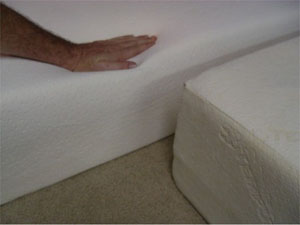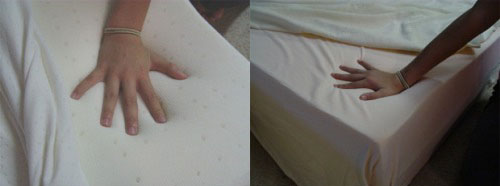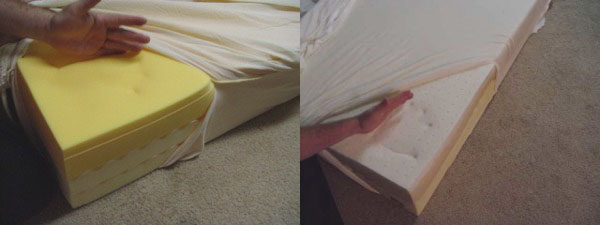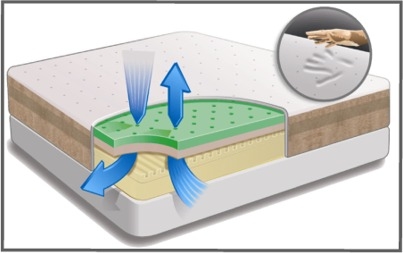
Both the Tempflow(TM) (left side) and the
Tempur-Pedic(R) (right side) Mattresses were placed side
by side for Comparison purposes. |
Reporting on the latest space industry new has
enabled myself, as well as the rest of the Space Daily staff, to
witness some of the greatest technological advancements in the
space industry. However, one of our most fond advancements has
been the one we get to enjoy personally on a daily basis...the
creation of NASA's space age visco-elastic (also known as memory foam) used so
widely in the bedding industry.
In case you might not already
know, the leading company who produces visco-elastic foam
mattresses is Tempur-Pedic(R). They were the first to market
NASA's technology in the 1980s and the Tempurpedic mattress line
has increased in market share steadily since. Over the last five
years there has been an explosion in the bedding industry with
many other mattress companies bringing their own visco-elastic
foam mattresses to the market place.
However, it is unclear how many
of these mattresses really offer a similar feel and quality that
the Tempur-Pedic(R) brand image has been able to spring board off
of. The feeling I am referring to, in case you have been living
on Mars and haven't tried one out yet, is the sensation of your
total body being supported as if the mattresses was being molded
around you, only to have it slowly come back to shape after you
roll over.
To be fair, not every person
has felt that visco-elastic space age foam mattresses are the
best choice, citing that they can often get too hot because of
the lack of breathability that occurs with the very dense visco-elastic
foam.
That is why we were excited to
test out a new patented visco-elastic memory foam mattress
called the Tempflow(TM), which claimed to offer a ventilation
system to keep you cooler, while comparing in feel, support and
comfort to the Tempur-Pedic(R) brand.

The Tempflow(TM)
uses a patent pending technology that allows body
heat to ventilate out the mattress, while cooler air
can flow back into the mattress. See
www.Tempflow.com for more information about how
their technology works.
|
They did so by offering a design that uses many
small ventilated holes that travel through the surface of the
memory foam and exit through the convoluted airflow channel
middle layer. While the patent pending design of the Tempflow(TM)
looked impressive, we wanted to take it one step further and
actually compare side by side this new mattress to the
TempurPedic mattress model that they believed it most directly
compared to. They chose the Deluxe bed by Tempur-Pedic, so we
ordered one of each for comparison testing purposes (the Deluxe
bed has been renamed as the Tempur-Contour Signature since our
original purchase, but the overall design is basically the
same).
Upon inspection of the two
mattresses, we noticed that the covers both seemed to be made of
a stretchable, thinner velour material (since the time of this
first article, Tempflow is offering an upgraded bamboo Kool-Flow(TM)
stretch cover and the Tempurpedic mattress below is currently using a
Multi-Fiber knit cover). After removing the covers of both
mattresses, we found a thinner socking material that we were
informed was used to make mattresses fire resistant. Each
mattress had an approximate one inch top layer composed of a
softer visco-elastic foam, followed up by what appeared to be
three inches of a slightly firmer visco-elastic foam.
 Tempflow(TM) (left) and Tempur-Pedic(R)
Deluxe Bed (Updated to the Tempur-Contour Signature)
(right) both use socking material for fire resistance.
the socking material is thin enough to allow the foam to
conform around the body.
Tempflow(TM) (left) and Tempur-Pedic(R)
Deluxe Bed (Updated to the Tempur-Contour Signature)
(right) both use socking material for fire resistance.
the socking material is thin enough to allow the foam to
conform around the body.
|
The formally DeluxeBed (now Tempur-Contour
Signature) has two layers of what appeared to be the same type
of bottom base foam, while the Tempflow we tested had only one
thicker bottom base foam layer. Both mattresses use a convoluted
area on the surface of the base foam with peaks and valleys that
enabled airflow to travel across them, although the Tempflow
channels now use squared off peaks (presumably for more channel
strength).
When I pushed on the surface
foam for each mattress, I was able to feel air come out the
sides of both mattresses at the convoluted side portions.
However, with the patented ventilation technology of the
Tempflow, I was able to also feel air come out the top through
the many small holes in the visco-elastic foam on the surface,
where as I could not feel any air come through the Tempur-Pedic
visco-elastic foam surface. Then came the most important test of
all, the direct comparison of lying on both mattresses and
testing the pressure comfort, feeling of proper support, and
temperature comfort.

With the socking removed, it was
apparent that both the TempurPedic(R) DeluxeBed
(Updated to the
Tempur-Contour Signature)
(left) and Tempflow(TM) (right) use four
inches of top memory foam divided up into two layers and
both have convoluted base foam underneath to increase
airflow. However, the Tempflow(TM) has many small
ventilation holes that go through the top layer surface
down to the airflow convoluted air channel layer. See
www.Tempflow.com for more information about how
their technology works.
|
After going back and forth from
one mattress to another several times, I have to admit that I
did not discern much difference in the memory foam sensation and
overall mattress feel between the two mattresses. I also had
several staff members perform the same test.
The best that I, as well as the
other Space Daily staff members could come up with, is that the
Tempflow(TM) may start off feeling a bit softer initially, but both
seemed to feel the same after lying on them for several minutes.
At that time I did not feel
that I could make a decision about which one kept my body
temperature cooler, as I knew that from my past experience that
it may take several hours on a mattress to determine how hot it
can get. So I did just that.
After splitting a night's sleep
on both mattresses, I was able to verify that the Tempflow(TM) did
indeed keep my body cooler overall. It is also a consensus from
the other Space Daily staff members who have since slept on the
two mattresses, that Tempflow(TM) does indeed live up to its claim
of being able keep the body cooler. Since the time of my first
review for the Tempflow mattress, they have come out with three
models and are now using what they call their Biogreen(R) memory
foam.
One of their models, called the Eros(TM), uses this new Biogreen visco-elastic foam. It feels just a touch softer than our Tempur-pedic Deluxebed(TM) (updated to the Tempur-Contour Signature) and in our estimation, it is somewhere between the feel of the Tempurpedic RhapsodyBed(TM) and GrandBed(TM). For those that want a firmer feel than the Tempur-Contour Signature, Tempflow offers the Eclipse, Selene(TM) and Copia(TM) mattresses (the Eclipse being most similar to the original Tempurpedic mattress and the Copia being most similar to the Tempurpedic Rhapsody in configuration and feel). With the immediate softness of their Gaia(TM) and Celestia(TM) models, you will get that similar, instant reacting, plush comfort felt in the Tempur- Cloud(TM) Supreme and Tempur-Cloud Luxe mattresses. For those that are looking for more of cross blended, hybrid type mattress, the newest Flexia model compares with the Tempur-Pedic Weightless Deluxe.
With so much green washing these days, it was nice to learn that the Biogreen memory foam has been independently tested by the same laboratory that heads up GreenGuard's certification testing (see www.GreenGuard.org). UL laboratories tested the Biogreen memory foam for total V.O.C.s (Volatile Organic Compounds), which account for much of that initial smell that many people complain of when they first get a new mattress. In addition, the Biogreen foam was analyzed for many specific chemical emissions, such as phthalates, benzene, styrene, formaldehyde and many other dangerous substances. The results were that the Biogreen memory foam was shown to have approximately 13 times less in total V.O.C.s than the allowable requirements set from strict 3rd party environmental certification organizations, such as Certipur-US and Oeko-tex (00.039 parts per million to their 00.5 parts per million allowable level). It was also approximately 13 times lower than GreenGuard's Indoor Air Quality total V.O.C. requirements and approximately 6 times lower than Greenguard's most stringent Schools and Children total V.O.C. requirements. To go along with the Biogreen memory foam, the rest of the mattress uses a channeled resilient foam layer underneath the Biogreen memory foam, which has been Certipur-US Certified and a waterborne adhesive that is used to bond the layers and has been Greenguard certified. They also use a fire resistant outer socking material, which is free of dangerous chemicals, such as PBDE, Bromine and Boric acid, as well as being biodegradable. While both mattresses have been rated safe, we can't help but be impressed by the fact that the whole Tempflow mattress, not just the Biogreen memory foam, is an environmentally green way to go.

The Tempflow(TM) uses a patent pending
technology that allows airflow to circulate through the
foam via a patent pending ventilation system. New to the
Tempflow model is their proprietary Biogreen(R) memory
foam. See
www.Tempflow.com for more information about how
their technology works.
|
Both mattress The Tempflow(TM) uses a patent pending technology that allows companies show their airflow to circulate through the foam via a patent pending ventilation confidence in the system. New to the Tempflow model is their proprietary Biogreen(R) longevity of the memory foam. See www.Tempflow.com for more information about mattresses by offering how their technology works. 40-year limited warranty for the Tempflow(TM) and a 25- year limited warranty for the Tempur-Pedic(R) mattress. Both companies offer a sleep trial to ensure that you are completely satisfied you're your purchase, but the Tempflow(TM) offers a 120-day sleep trial, as compared to Tempur-Pedic(R)'s 90-day sleep trial.
Needless to say, my staff and I
agree that this new patented technology that the Tempflow(TM) uses,
really offers a way to get the feel and support of the leading
brand and very popular Tempur-Contour Select model from Tempur-Pedic(R),
but with a cooler airflow ventilation system.
Therefore, we unanimously
decided to give the Tempflow(TM) visco-elastic foam mattress our
Space Daily product innovation award for making excellent use of
NASA's space technology for home use and bringing to the market
place a new, innovative technology that really works.
Tempflow is a trademark of Relief-Mart,
Inc. Tempur-Pedic is a registered trademark of Dan-Foam A/S
Corporation. We don't sell either the Tempur-Pedic or Temperflow
brands. The information on this site with regard to Tempflow and
Tempur-Pedic mattress brands is strictly for comparison
purposes.
